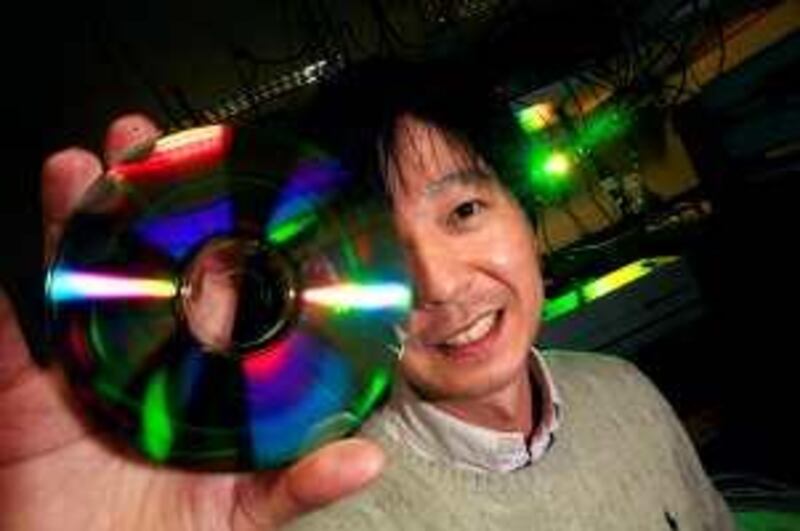SYDNEY // Scientists in Australia have developed a DVD that can store up to 400 times more information than a standard disc. The technology records in an unprecedented five dimensions and is capable of packing away 1.6 terabytes of data. It has immense possibilities for the archiving of digital material as well as offering changes to the way movies are enjoyed at home by allowing viewers to watch individual scenes from a variety of viewpoints.
"If you have, for example, nine angles that you can choose to view the movies then you require nine separate movies to be recorded into a single disc. That means you need nine times more space for this technology to be possible," said James Chon, a senior lecturer at Swinburne University's Centre for Micro-photonics in Melbourne. These scientific advances go beyond conventional DVDs. Up to 400 standard-definition films or 70 high-definition movies can be stored on an individual disc.
Using tiny gold particles, researchers have been able to exponentially expand capacity by adding three extra recording dimensions through highly complex treatments of light and colour to create vast amounts of additional space. "In the current CD and DVD technologies you have one single recording layer and they are only using one colour of light and one polarisation," Mr Chon said. "What we were able to demonstrate is to record optically in multiple dimensions. This includes three spatial dimensions, one colour dimension and one polarisation dimension."
Despite taking such a formidable leap beyond today's electronics, the fundamental process of recording and decoding in five dimensions has similarities to the present DVD system, leading Mr Chon to predict that a commercially viable device could be available within five years. These eye-catching developments have caused ripples of interest in the broader scientific and technological community. "It is really the next step in breathing life into optical media and providing enormous amounts of storage," said Peter Blasina, who is known as Australia's "Gadget Guy" and runs a website that reviews the latest technology for consumers.
"It is an exciting development because the assumption generally was that optical media had virtually reached its theoretical limits with Blu-ray and this lifts the storage capacity to another level," Mr Blasina added. Blu-ray discs have space for one high-definition movie, while conventional DVDs have a capacity of five gigabytes and can hold a single standard-definition film. In boldly pushing the boundaries, the team at Swinburne University used multicoloured lasers to explore different frequencies within the light spectrum to generate deep wells of extra space.
The essential ingredients are minute gold fragments that are used to record the digital data and whose size can be altered to respond to different colours of light, a function that is critical to the process of expanding disc storage. "In order for this to be possible we used special marvels called gold nanorods. These rod-shaped particles respond to different colours of light depending on their length," Mr Chon said.
At the heart of the ground-breaking research is the intriguing world of nanotechnology, which is micro-engineering on the scale of atoms and molecules. It deals with structures usually 100 nanometres or less (a nanometre is one-billionth of a metre). Advocates have insisted this intricate type of science has enhanced almost every aspect of daily life - from the power of computers and other electronic appliances to energy supplies and medicines.
"I cannot think of an area where nanotechnology has not had an impact," said Chennupati Jagadish, a professor of nanotechnology at the Australian National University in Canberra. "People are using nanotechnologies for developing a range of photovoltaic solar cells for producing efficient energy, and another area is controlled drug delivery," he said. "We'll be able to send the chemicals needed to treat cancer without affecting other cells around this cancer requiring only a very small amount of drugs and the cost of the treatment will be significantly reduced."
Scientists at Swinburne University are working with Samsung, South Korea's largest company, to refine its DVD research and although no commercial deal has yet been reached, the project has prompted enquiries from elsewhere. "We have had interest from archival storage companies that would like to explore the possibilities of permanent recordings in one single disc," he said. "At the moment such storage requires a massive array of hard drive or solid state memory devices, which cost quite a bit to maintain. Our solution can be permanent archives that can be stored in a cool place and will stay forever."
Mr Chon has designs on pushing the frontiers even further, creating a 10-terabyte disc, which is way beyond what other experts have thought possible. "You can only have enormous respect for these guys that can take a current bit of technology and completely rethink it," Mr Blasina said. "It just is a remarkable talent and I think the human mind is something that we know so little about." pmercer@thenational.ae





